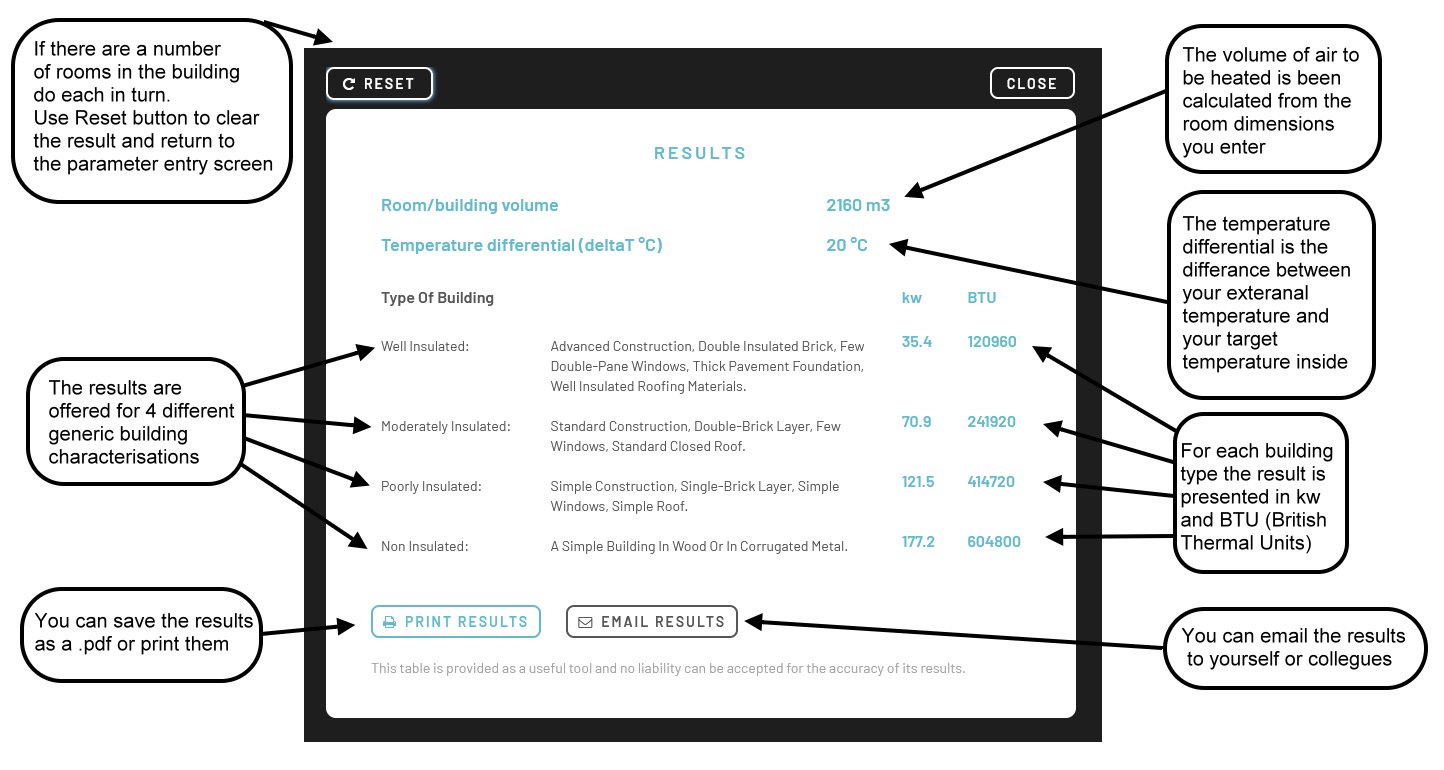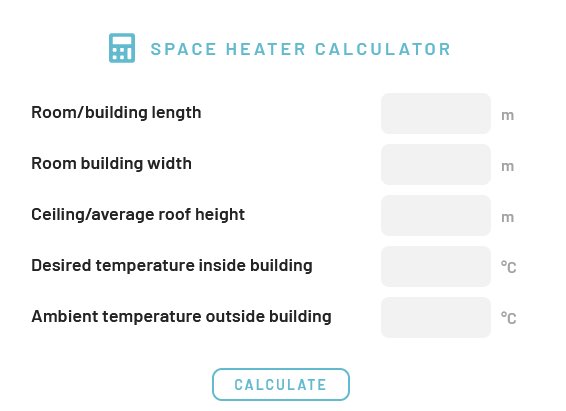Space Heating Calculator
Introduction to the Space Heating Calculator
Before you look for a space heating solution it is well worth understanding how much heat your building needs. This is where our space heating calculator comes in useful.
Our space heating calculator tool is aimed at commerical and industrial type spaces rather than for domestic applications. It does not require the level of detail that is required for heat loss calculations (i.e. u-values, window sizes etc. ) but it is simple enough to provide an easy estimate of how much heat you need. For the vast majority of applications is it more than enough to establish your heating requirements.
Online space heating calculators vary. Some are complex and very detailed whilst others are more straight forward. Ours is straight forward. This means the inputs and the results of our space heating calculator need to be more carefully considered. Here is some extra detail to help you understand the calculator;
Notes about the inputs for the space heater calculator
Dimensions
Sometimes rooms do not have simple rectangular dimensions. In that case one trick is to sketch out your floor plan and break it into shapes for which the area can be easily calculated (triangles, rectangles etc.). These areas can be added together to get the overall floor area for the room. Then calculate the square root of the total area. Use this value for both the room length and room width boxes of the space heater calculator.
Ceiling/average roof height
We mentioned that this calculator is really designed for commercial and industrial applications rather than domestic. This means that we are talking about buildings which are typically factories, industrial units, sheds or open plan offices. It is the size of the box of air we are trying to define. Often the height can be the line of the roof or sometimes there is a suspended ceiling which is the upper limit of the box of air. If a sloped roof is the upper limit of the room then calculate the average height and use that in the calculator rather than using the maximum height.
Desired temperature inside the building
Consider what temperature you need in order to suit the purpose of the building. It might be a storage facility where a minimum temperature needs to be maintained to prevent spoilage of goods or condensation. Or it could be to keep staff comfortable. We usually recommend that if staff are moving about and doing physical work then you would probably be aiming for a temperature between 14- 16°C, if they are seated and doing dexterous work then 17-20°C would suit. Work places generally do not need to be heated to the same temperature as homes.
Ambient temperature outside the building
You may want to consider...
- Is the air on the other side of the wall the external environment or another part of the same building?
- Are you in a very cold part of the country or perhaps a relatively warm area?
Assuming that the other side of the wall is external, then we recommend setting the ambient temperature to -5°C. This is fine for most parts of the UK , except the Highlands in Scotland for which set the value to -10°C. That is not to say that the external temperature will not occasionally be lower than this, but it these values are reasonable for calculating heating requirements. If the room to be heated is itself in a building which has a minimum temperature that is above that outside then use this temperature instead.
Understanding the results from the space heating calculator
When you have the results from using the space heating calculator you then need to decide which value of kw you should use. The results will be very different depending on the characteristics of your building, how it is constructed and how well insulated it is.

Other considerations when using the space heating calculator
- We offer 4 generic building discriptions. For your application it may reckon that your building is not quite as well built or insulated as one type but better than the description that we offer for the next one down. It is not a problem - just chose a heat requirement value that is between the two adjacent building types.
- With space heating calculators it is worth remembering is better to over size heating than undersize. Once you have used the space heating calculator to work out what heating capacity is needed in your application, aim to select heaters that will produce the required heat or heaters that produce slightly more heat. You can not make a heater produce more heat that its rated heating capacity. Whereas you can turn an larger capacity heater down to meet the buildings heating requirement.
- Heaters are almost always controlled by thermostats. This means the heaters selected will deliver the heat required rather than produce heat to the capacity of the heater. If the heaters are selected to match or better the heating requirement, the running cost will be the same, i.e. matched to the building heating requirement rather than the heater capacity. Over sizing heating capacity means that your heaters will be able to heat up the building up more quickly than if you used smaller capacity heaters.
- By asking 'what if' type questions and reworking the calculation you will understand more about your heating options. For example, what if...
...it was heated to a lower target temperature?
...we added more insulation to the building?
...a smaller space was heated say by making a room within in the wider building and only heating that ?
What next?
So you have used the space heating calculator and you need some heaters. Call us!

